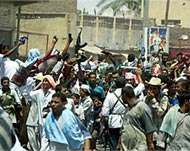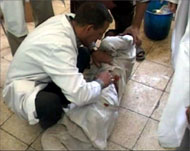Al-Sadr aide contests US toll claim
US marines say they have killed an estimated 300 Mahdi Army fighters in Najaf in the past two days, but a Muqtada al-Sadr spokesman says most of those killed were civilians.

The spokesman said only 36 fighters had been killed in several Iraqi cities after clashes that have fuelled fears of a new rebellion among Iraqi Shias.
The fresh fighting, which continued on Friday, marks a major challenge for the interim government of Prime Minister Iyad Allawi and appears to have destroyed a two-month-old ceasefire between US forces and al-Sadr’s Mahdi Army.
“The number of enemy casualties is 300 KIA (killed in action),” Lieutenant-Colonel Gary Johnston, operations officer for the 11th Marine Expeditionary Unit, said at a military base near the city, 160km south of Baghdad.
Johnston told reporters the Mahdi Army fighters were badly coordinated and shot at random against the heavily armed marines who were backed up by helicopter gunships and fighter planes.
“There is fighting right now. In some ways it is not as intense as yesterday,” he said.
No accurate figures
US military officials said there were indications that foreign fighters had joined the Mahdi Army. Criminal gangs were also involved, they said.
 |
|
Al-Sadr has a following among |
Johnston said there were two dead and 12 wounded US soldiers from the two days of fighting.
Fifteen US occupation troops were also wounded in fighting in the Sadr City district of Baghdad.
The US-appointed governor of Najaf put the death toll among Shia fighters at 400, with 1000 captured. He said he had information that 80 Iranians were fighting alongside al-Sadr’s militia.
Shaikh Raed al-Qathimi, a spokesman for al-Sadr, contested the US version of the death toll.
“I categorically deny these American lies,” he said, adding that only 36 Shia fighters have been slain in the clashes.
Another al-Sadr spokesman, Shaikh Mahmud al-Sudani, told Aljazeera both sides had suffered casualties and “there were no accurate figures due to the violent fighting which is still under way”.
He added that US forces had violated the truce between the two sides as well as the sacredness of Imam Ali’s tomb which was subjected to shrapnel damage caused by nearby explosions.
Tension flare-up
Meanwhile, British and Italian troops also fought the Mahdi Army across Shia-dominated southern Iraq – in Basra, Amara and Nasiriya – while fighting raged in Sadr City and Shoula, two Shia districts of Baghdad.
 |
|
British troops have been fighting |
The Health Ministry said fighting in Sadr City alone had killed 20 Iraqis and wounded 114 since early on Thursday, while in Nasiriya six were dead and 13 wounded.
Tension has been rising in Najaf since Iraqi security forces surrounded al-Sadr’s house earlier this week.
US marines recently replaced the US army in Najaf and analysts have suggested the upsurge in violence is linked to the marines taking a more aggressive approach with al-Sadr’s militia.
Militiamen shot down a US helicopter as it was trying to evacuate a wounded soldier on Thursday. No one was killed, but the pilots were wounded.
Early on Friday F-16s, AC-130 gunships and helicopters patrolled the skies over Najaf, covering US troops battling resistance fighters in and around Najaf’s cemetery.
Fighting also flared near Najaf’s shrines, some of the holiest for Shia Muslims, and some said that gunfire had damaged the dome of the Imam Ali shrine.
The flare-up of tension with members of Iraq’s Shia community comes after Shia fighters rose up across south and central Iraq in April and May.
Call for renewed truce
 |
|
Hundreds of al-Sadr loyalists had |
In the previous uprising, hundreds of Iraqis and dozens of US troops were killed.
Al-Sadr, with an ardent following among poor, disaffected youths, appeared keen to stop the latest fighting.
Via his spokesman in Baghdad, he called for a resumption of a truce struck in June.
“We have no objections to entering negotiations to solve this crisis,” Mahmud al-Sudani said. “As I have said in the name of Sayid al-Sadr, we want a resumption of the truce.”
Ayat Allah Ali al-Sistani, the highest Shia authority in Iraq, has carefully and quietly tried to temper al-Sadr’s words and actions.
But in a worrying move for his followers, al-Sistani, 73, flew to London on Friday for treatment for a heart problem, sources said.